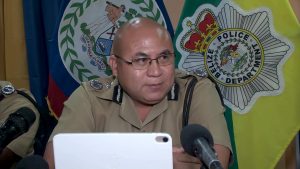Unearthing the Wonders of Xunantunich
When we think of national treasures, few things rival the majesty and mystery of our ancient Mayan heritage. Towering above the lush jungle canopy, these awe-inspiring structures are more than just stone, they’re silent storytellers of a civilization that once thrived in our very own backyard. Tonight, on Belize on Reel, News Five’s Britney Gordon takes us deep into the heart of the Cayo District, where the iconic Xunantunich site stands tall once more, thanks to the tireless efforts of conservationists and archaeologists. Join us as we uncover the secrets of the past and celebrate the legacy that continues to shape our identity. Here’s that story.
Britney Gordon, Reporting
“Xunantunich. Its one of Belize’s most popular archaeological sites. Known for its many majestic structures that are still in great condition. What I’m standing in right now is the El Castillo, which was used for a multitude of reasons, But primarily, it was the living quarters of royalty. But did you know that just over a hundred years ago, all this was completely underground.”
El Castillo stands at one hundred and thirty feet, overlooking an altar and residential structures in the plaza.
Britney Gordon
“From the top of the El Castillo structure, you can see the towers in San Ignacio, Santa Elena, but take just a few steps over and you can start to see San Jose Succutz, Benque Viejo, and Melchor.”
So, how do incredible structures like El Castillo rise from the jungle once again? It’s all thanks to the careful and determined work of archaeologists like Antonio Beardall. Back in 2022, Beardall and a group of students rolled up their sleeves and began the painstaking process of uncovering one of the smaller buildings at the site. He explains what makes Xunantunich stand out from other ancient structures and why it continues to capture the imagination of so many.
Antonio Beardall, Archeologist
“What is most unique about this is that Xunantunich did not really come to power until very late. And it was a huge city at that time for about one hundred and fifty years. So you have other sites around the place like Cahal Pech a site called Actun Kan to the North. And these sites had people for centuries, people were living here, but it took a while for them to establish dominance in the region. And that’s what makes it interesting is that some of these structures were built in a single construction phase, whereas other sites, the structures have many different phases going down. On the El Castillo, there are many interesting parts of it that people might not notice at first. Right here, we have the sun god called Kinich Ahau, which can be identified by its crossed eyes and its buck teeth.”
Once these ancient structures are uncovered, the real challenge begins: keeping them standing. Belize’s national conservationist, Jorge Can, leads the team in charge of that mission. They don’t rebuild anything new; instead, they focus on strengthening what’s already there using special materials. But figuring out exactly what works best takes careful testing and analysis.
Jorge Can, National Conservator, Institute of Archeology
“They were using cement and sand. But then later on we began to see that no, it is damaging the structure, the stability of the structure, although the cement and the sand is very hard for a modern building. But over here we have to use soft materials that could bend contracts with the structure.”
Now, the team at Xunantunich uses mainly materials utilized by the ancient Mayans for conservation. However, this method doesn’t work for everything. The Freize, an intricate carving on the El Castillo, was reconstructed entirely to preserve the original.
Jorge Can
“Everything was disintegrating, deteriorating very fast. So we had to end up with a next technique that we actually, we came about with the, with our neighboring with the Mundo Maya, with Mexico and Guatemala and Copan, which is Honduras. We began to use fiberglass replica. So we are using replica now. So actually, the original stays at the box. We buried the original and we place a replica in front.”
The story of Xunantunich is far from over. As the sun rises over the ancient stones, teams of researchers continue to dig, both literally and figuratively, into Belize’s rich Mayan past. But what’s truly inspiring is who’s doing the digging. Archaeologist Antonio Beardall points out that many of the latest discoveries aren’t just coming from seasoned experts, they’re being made by Belizean students. These young researchers are getting hands-on experience at one of the country’s most iconic sites, helping to uncover buried artifacts and long-lost structures.
Antonio Beardall
“We knew that something was there because the people who had worked in the courtyard previously had documented. That they had found this deposit in front of the structures. So we figured we will probably find something similar. And we did. And it was essentially like a small carpet of artifacts. Everything from stone tools to broken pots, to tools that the Maya women used for weaving all in this one area. And to see these things and for the students to understand like what this small little thing means and how long ago it was it was made unused. It connects who we are in the present to the people who were there in the past.”
It’s a powerful reminder that the future of our history is in good hands. Britney Gordon for News Five.






Facebook Comments